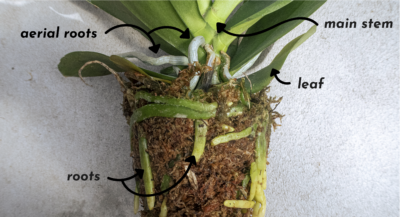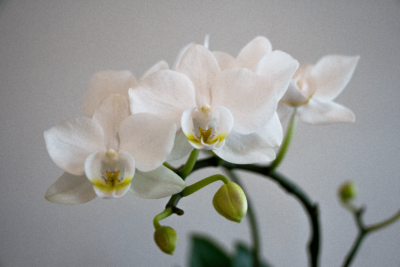
Orchid
[Orchidaceae] plant.
Plant Type: Houseplant
Light Needs: Bright, indirect sunlight
Water Needs: Once or twice a week
Bloom Season: Early spring/late fall
Native To: All continents except Antarctica
Average Size: 1-3ft. tall, 6-12in. wide
Pet Safe: Yes
Orchids are the largest family of flowering plants in the world.
In every landscape where plants can grow, you will find orchids. An orchid has a symbiotic relationship with the microscopic fungi that co-exist within the root structures and releases nutrients that are absorbed by the orchid. Orchids need these fungi to exist and each fungus species is unique to an orchid variety. Therefore, wild orchids are often found in colonies where their specific fungus grows. The plants are pollinated by insects, hummingbirds, and even bats, making seed reproduction at home very difficult.
When caring for orchids, it is essential to research the unique requirements of the orchid you have, since maintenance is not the same across the board. The types of orchids most widely available on the market are either terrestrial or epiphytic. An epiphyte is a plant that grows upon a host tree as an “air plant”. Most of the commonly grown house plant orchids fall into this category, including phaleonopsis, dendrobium and vanda. Terrestrial orchids, such as the native New England Lady Slipper, are found naturally growing in a heavy soil mix or leaf litter with mulch bark and organic matter and they usually produce tubers or matted roots.
LIGHT
Orchids grown indoors can take as much light as you can expose them to with the exception of direct sunlight in hot summer months, which can cause them harm as it would any plant. In nature, orchids are shade-loving plants, so make sure to keep them shaded if they are outdoors during the summer.

TEMPERATURE
Cool growing orchids such as cymbidiums require a minimum winter daytime temperature of 68 ℉ and a night time temperature of 50 ℉. Their maximum summer daytime temps. will be 86 ℉ with night time temps. of 55 ℉.
Intermediate growing orchids such as cattleyas and paphiopedilums require winter daytimes temps of 68 ℉ with nighttimes of 55 ℉ and summer daytimes of 86 ℉ with nights of 55 ℉.
Warm growing orchids such as phaleonopsis require winter daytimes of 70 ℉ with nights of 64 ℉ and summer daytimes of 90 ℉ with nights of 64 ℉
If your orchids are not blooming, the problem is likely light, temperature or both. Avoid putting them in drafty areas where temperatures fluctuate often.
WATER
When orchids are growing, it’s important to keep them consistently moist, and to avoid letting them become too wet or too dry. As a general rule, water orchids once or twice a week in the growing season and once every two or three weeks during the dormant period. The frequency of watering will depend on light, temperature and how fast the orchid drys out after waterings. Feel the top and bottom of the pot to get an idea of how moist the plant is. If it’s still moist, don’t water it.
Shriveled pseudo bulbs or limp leaves can be an indicator of too much or too little water but it is best to check the roots of the plant. The most efficient method of watering is submersion or a drenching mist if the plants are true “air plants”. You can add humidity to your plants in between waterings by using a home humidifier, misting, or placing plants on a tray with pebbles and water.

SOIL
Be sure to provide the correct soil mix for your particular orchids. Epiphytes require high humidity around their roots but shouldn’t be saturated with water. Often times, these plants will be in indoor pots with roots growing out of the pot. This does not necessarily mean that the plant needs to repotted, as the roots can still get moisture and nutrients from the air. Epiphytes can be planted in soil mixes that contain bark, volcanic rock, horticultural charcoal, perlite, baked clay pellets and plastic foam such as packing peanuts or sphagnum moss. All of these provide good drainage and allow
roots to remain humid but not saturated.
Terrestrial orchids are often planted in bark mixes with compost (for soil nutrition) and added drainage materials such as peat and perlite. Orchid soil mixes like Better Gro Special Orchid Mix are available commercially.

REPOTTING
The best time to repot an orchid is in the spring or fall when the plant has finished flowering. It is important not to increase the pot size too much (sometimes you can use the same size). If the new pot size is too large, the soil will stay really wet after watering and rot the roots.
If an orchid is pushing up out of the pot or is choked with pseudo bulbs (a swollen stem used for water storage above ground) or if the soil mix is old and broken down, then it’s time to repot. It can be as easy as putting the plant in a container that is a few inches larger and adding additional mix to fill it in. This type of repotting can be done at almost any time of year.
Repotting and dividing requires a bit more attention to detail. This refers to the process of stripping out the old mix, pruning any dead roots, removing excess pseudo bulbs and splitting the plant if needed. Only then can you pot with the correct mix. Plastic or terracotta pots are recommended as they are the easiest in which to keep moisture levels accurate. Also, pots with holes in the sides that allow water to escape will work well and are often referred to as “orchid pots”.
FERTILIZER
Orchids are weak feeders. They feed to maintain steady growth momentum, health and vigor for a long life. Use a specially-prepared fertilizer for orchids and follow label instructions. Examples of orchid fertilizers available commercially include Better Gro Orchid Plus 20-14-13 or Better Gro Orchid Bloom 11-35-15. You can also use house plant fertilizer at ½ the weakest recommended dose. Fertilize orchids every second or third watering when the plant is actively growing. When dormant, fertilize less or none at all. If the plant is in a mix that contains little or no organic matter, feeding frequency can be increased.
For more information that is always in bloom, visit our: Plantopedia Blog